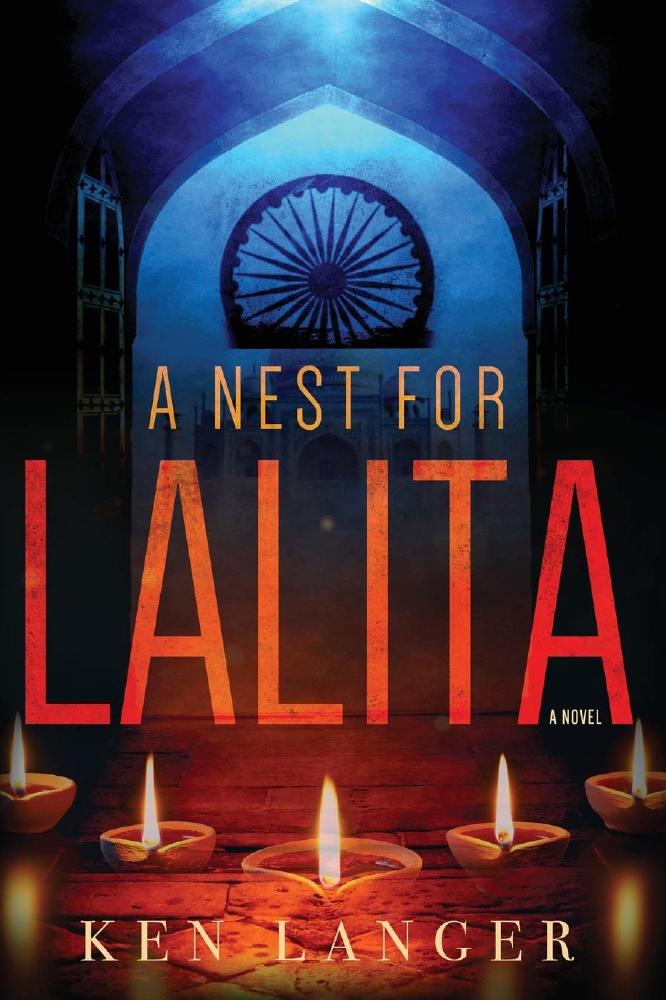1. I fell in love with India. From the moment I read Patanjali’s Yoga Sutras during my first year in college, I knew India would be a big part of my life. Decades later, after I’d sold my green-building consulting company, I still had a young family and couldn’t travel extensively. Setting my novel in India was a way for me to escape to my old haunts without leaving my backyard.

A Nest for Lalita
2. I came to realize that India was more than Sanskrit love poetry. My Ph.D. dissertation was on Sanskrit love poetry, a literature written by men and for men. The women were always beautiful, timid (though sometimes cagey), and forgiving. With time, I began to see this poetry with a wider lens. When I decided to write a novel, I wanted to turn the tables – to write from a modern Indian woman’s point of view.
3. I became a Hindu. During my year in Varanasi, my girlfriend and I knew a couple who decided to become Hindu and have a Hindu wedding. They asked me if we wanted to join them and have a double wedding. I say, no thanks, we’re platonic. “Well, my friend continued, then do you want to become Hindus with us?” Why not, I thought. It was a traditional ceremony with priests chanting of Sanskrit and pouring lots of ghee into a fire. Do I practice Hinduism? No, but I love the gods and goddesses, especially Shiva, whom I would vote the sexiest man on earth. Well, if he were a man.
4. Was I qualified? Who knows? I hope readers will not toss the novel simply because it is written by a white American male. I’ve spent years living in India, studied Indian culture for over a decade, and was once married to an Indian woman a social activist. We lived in New Delhi and socialized with many progressive women working on social issues. Getting inside the head of Meena, the protagonist, was not difficult.
5. Writing this novel was a way of atoning. Having Meena, the protagonist, run a home for women survivors of domestic violence gave me an opportunity to expose one of India’s worst social ills. In a sense, I was atoning for my unquestioning commitment to Sanskrit love poetry, which paints a rosy picture of India and its women.
6. The bird’s nest in the title is a green building. Having founded and managed America’s first international green-building consulting company, I became intrigued by the way sustainable architecture not only saves energy, water, and other natural resources, but also improves the physical and mental health of those working or living inside. Through Simon, the American architect who is commissioned by Meena to design a new community center, I wanted to create a green building whose very nature would help nurture and heal women who’ve suffered abuse.
7. I feared women wouldn’t get past page 10. One of my characters, Meena’s husband Kesh, is misogynous and delights in spewing forth politically incorrect humor and hurling tasteless zingers. I feared women would immediately dislike him and trash the book before finishing the first chapter. Fortunately, I was proven wrong, for female readers have told me that they like the fact that Kesh is always challenged whenever he starts to speak nonsense.
8. Hindu nationalism is NOT the BJP. In the beginning of my novel, Meena loses funding for her new campus. The ultra-right-wing Hindu Democratic Party (HDP) steps in with a large grant. Meena has no choice but to accept the money, but her worst fears come to pass when the HDP starts to turn the clock back on women’s rights. I’m afraid people familiar with India will immediately see the HDP as a stand-in for the ruling party. But the HDP is not the BJP. Its main agenda is not social purity, but rather to return India to a golden past when women “weren’t trotting off to Bangalore in torn jeans for hi-tech jobs.”
9. Many vignettes are drawn from my personal experiences. As a teen, I learned how to throw my voice and performed as a ventriloquist, just as the young Simon. The story of Simon’s ten-hour shower to flush the chemicals out of his arm after an explosion comes from my own diary, as do other scenes. And, having been in the green building industry, I had great fun creating a character who is America’s leading sustainable architect. There’s a lot of me in this novel, although I’m spread over different characters.
10. I have a wonderful family – a lovely and talented wife and two beautiful, smart daughters. When I’m not writing in my “man cave,” the cabin I built behind my house, I can usually be found playing the cello, doing yoga, gardening, cooking Indian food, or just meditating on my navel.
A Nest for Lalita by Ken Langer is available at all online booksellers. Published by Dryad Press £12.00 https://www.kenlanger.net
Ken Langer will be in conversation with Merrill Leffler on the 25th October at 8pm. Please see https://www.writer.org/event/ken-langer/ for further information.
Tagged in India

